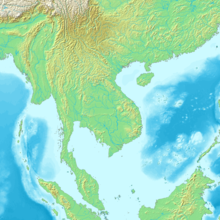

 | |
| Population | 243,201,036 (1 July 2019) |
|---|---|
| GDP (PPP) | $2.877 trillion (2021) |
| GDP (nominal) | $1.485 trillion (2022) |
| Countries | |
Mainland Southeast Asia (also known as Indochina or the Indochinese Peninsula) is the continental portion of Southeast Asia. It lies east of the Indian subcontinent and south of Mainland China and is bordered by the Indian Ocean to the west and the Pacific Ocean to the east. It includes the countries of Cambodia, Laos, Myanmar, Thailand, Vietnam, and Peninsular Malaysia.
The term Indochina (originally Indo-China) was coined in the early nineteenth century, emphasizing the historical cultural influence of Indian and Chinese civilizations on the area. The term was later adopted as the name of the colony of French Indochina (today's Cambodia, Laos, and Vietnam). Today, the term Mainland Southeast Asia, in contrast to Maritime Southeast Asia, is more commonly referenced.

The origins of the name Indo-China are usually attributed jointly to the Danish-French geographer Conrad Malte-Brun, who referred to the area as indo-chinois in 1804, and the Scottish linguist John Leyden, who used the term Indo-Chinese to describe the area's inhabitants and their languages in 1808.[1] Scholarly opinions at the time regarding China's and India's historical influence over the area were conflicting, and the term was itself controversial—Malte-Brun himself later argued against its use in a later edition of his Universal Geography, reasoning that it overemphasized Chinese influence, and suggested Chin-India instead.[2] Nevertheless, Indo-China had already gained traction and soon supplanted alternative terms such as Further India and the Peninsula beyond the Ganges. Later, however, as the French established the colony of French Indochina (covering present-day Cambodia, Laos, and Vietnam), use of the term became more restricted to the French colony,[3] and today the area is usually referred to as Mainland Southeast Asia.[4]
Inbiogeography, the Indochinese bioregion is a major region in the Indomalayan realm, and also a phytogeographical floristic region in the Oriental Paleotropical Kingdom. It includes the native flora and fauna of all the countries above. The adjacent Malesian Region covers the Maritime Southeast Asian countries, and straddles the Indomalayan and Australasian realms.[5]

The Indochinese Peninsula projects southward from the Asian continent proper. It contains several mountain ranges extending from the Tibetan Plateau in the north, interspersed with lowlands largely drained by three major river systems running in a north–south direction: the Irrawaddy (serving Myanmar), the Chao Phraya (inThailand), and the Mekong (flowing through Northeastern Thailand, Laos, Cambodia and Vietnam). To the south it forms the Malay Peninsula, located on which are Southern Thailand and Peninsular Malaysia; the latter is variably considered part of Mainland Southeast Asia or separately as part of Maritime Southeast Asia.[citation needed]

Mainland Southeast Asia contrasts with Maritime Southeast Asia, mainly through the division of largely land-based lifestyles in Indochina and the sea-based lifestyles of the Indonesian archipelago and Philippine archipelago, as well as the dividing line between the Austroasiatic, Tai–Kadai, and Sino-Tibetan languages (spoken in Mainland Southeast Asia) and the Austronesian languages (spoken in Maritime Southeast Asia). The languages of the mainland form the Mainland Southeast Asia linguistic area: although belonging to several independent language families, they have converged over the course of history and share a number of typological similarities.[citation needed]
The countries of mainland Southeast Asia received cultural influence from both India and China to varying degrees.[6] Cambodia, Laos, Myanmar and Thailand are all influenced by Indian culture, only Vietnam is influenced by Chinese culture but still has minor influences from India, largely via the Champa civilization that Vietnam conquered during its southward expansion.[citation needed]
Overall, Mainland Southeast Asia is predominantly Buddhist[7][8][9][10][11][12] with minority Muslim and Hindu populations.[13][14]
|
| ||||||||||||||
|---|---|---|---|---|---|---|---|---|---|---|---|---|---|---|
Muang Then (c. 6th-11th century)
Ngưu Hống (c. 10th-1432)
Tai Federation (c. 16th-1955)
Western Han (111 BC-501)
Tonkin (1883-1950)
Liang dynasty (502-544)
Annam (1883-1950)
Vạn Xuân (544-602)
North Vietnam (1945-1975)
Sui dynasty (602-618)
Tang dynasty (618-938)
South Vietnam (1955-1975)
Tĩnh Hải Quân (939-968)
French Cochinchina (1862-1949)
Đại Việt (968-1804)
Việt Nam/Đại Nam (1804-1945)
Champa (192-1832)
Lâm Ấp (192-629)
Simhapura (c. 4th-8th century)
Xitu (c. Mid 5th-6th century)
Quduqian (c. 300-Before 1480)
Khmer Empire (802-1431)
Kampuchea (1945)
Chenla (510-802)
French Cambodia (1863-1954)
Funan (68-627)
Gangga Negara (c. 2nd century-1026)
Old Pahang (c. 5th century-1454)
Pahang Sultanate (1470-1623)
Johor Sultanate (1528-1855)
Malacca Sultanate (1400-1511)
Straits Settlements (1826-1946)
Majapahit (1293-1527)
Unfederated Malay States (1895-1946)
Singhasari (1222-1292)
Federated Malay States (1895-1946)
Malayan Union (1946-1948)
Singapura (1299-1398)
Malacca (1946-1957)
Melayu (1028-1347)
Penang (1946-1957)
Srivijaya (671-1025)
Fed. Malaya (1948-1963)
Melayu (671-692)
Kedah Tua (c. 5th-9th century)
Pan Pan (c. 300-700)
Singapore (1946-1958)
Chi Tu (c. 2nd-7th century)
Langkasuka (1st-15th century)
Reman (1810-1902)
Patani (1457-1902)
Tambralinga (970-1365)
Setul (1808-1916)
Nakhon Si Thammarat (c. 13th century-1782)
Canasapura (c. 7th-9th century)
Ayutthaya (1351-1767)
Phrip-phri (Thai) [th] (c. 10th-13th century)
Phimai (1767-1768)
Phrip-phri (Mon) [th] (c. 6th-10th century)
Phitsanulok (1767-1770)
Sukhothai (1238-1438)
Thonburi (1767-1782)
Singhanavati (c. 658-1107)
Rattanakosin (1782-1932)
Ngoenyang (638-1292)
Lan Na (1292-1775)
Early Laos city-states (c. 6th-13th century)
Chiang Mai (1802-1899)
Lan Xang (1353-1707)
Phuan (c. 13th century-1893)
Vientiane (1707-1828)
Haripuñjaya (629-1292)
Luang Phrabang (1707-1893)
Dvaravati (c. 201-1099)
Champasak (1713-1904)
Mon city-states (c. 573 BC-825)
French Laos (1893-1953)
Thaton (c. 400 BC-1057)
Pong (c. 1st century-1479)
Möng Mao (568-1604)
Nanzhao (738-902)
Shan (1215-1555)
Mogaung (1215-1479, 1484 -1495)
Waithali (370-818)
Laymro (1237-1430)
Dhanyawadi (c. Early 4th century-369)
Mrauk U (1430-1785)
Ava (1365-1555)
Sagaing (1315-1362)
Konbaung Empire (1752-1885)
Prome (1482-1542)
British Burma (1824-1948)
Pinya (1313-1362)
Myinsaing (1297-1313)
Restored Taungoo (1599-1752)
Pagan (849-1297)
Toungoo Empire (1510-1599)
Sri Ksetra (c. 3rd century-1050s)
Hanthawaddy (1287-1552)
Tagaung (c. 1st century-1050s)
Restored Hanthawaddy (1740-1757)
Pyu city-states (c. 2nd century BC-1050)
│
0
│
100
│
200
│
300
│
400
│
500
│
600
│
700
│
800
│
900
│
1000
│
1100
│
1200
│
1300
│
1400
│
1500
│
1600
│
1700
│
1800
│
1900
│
2000
│
2100
│
2200 Timeline of sovereign statesinMainland Southeast Asia since the 1st century
| ||||||||||||||
| International |
|
|---|---|
| National |
|
| Other |
|